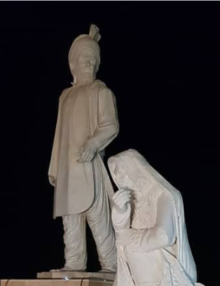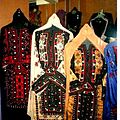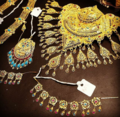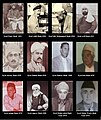|
Part of a series on Baloch People |
|---|
Community
|
|
HistoryAncient Medieval Baloch nationalism . Insurgency in Balochistan . Dad Shah . Baloch people in Iran . Baloch of Afghanistan |
| Culture |
| Languages |
| Religion |
Baloch traditional clothing (Balochi:جامگ، پوچ) is a historical and contemporary aspect of Baloch heritage and deep association between the traditional dress and Baloch ethnic identity.
The clothing of the Baloch people consists of various styles of kameez and shalwar, turban, shoes and head scarfs. Balochi embroidery decorations on dresses is a tradition in Baloch culture including Balochi cap, jackets, belts, ladies purse, shoulder bags, and many other items.

Background
Dress code and personal upkeeping are among the cultural values, which distinguish a Baloch from others. The Baloch dress and personal upkeeping very much resemble the Parthian ways. Surprisingly, no significant changes can be observed in the Balochi dress since the ancient times.
Baloch clothing is derived from Parthian clothing, especially Baloch men's pants are very wide like Parthian pants, but narrow near the hem or hem, and twisting causes folds in it.
The Baloch have worn their traditional clothing since ancient times, and this clothing was spread beyond the borders of Balochistan by ancient dynasties. The similarity of the clothing of Baloch men with other geographical regions such as India is as a result of the power of the Iranian ancient dynasties.
Balochi needlework or Balochi embroidery, is a type of Balochi handicrafts which is used on Balochi women's clothing, in some sources, the beginning of this art is 100 to 200 years before Islam, and the available evidence indicates that this method of sewing has been common among the Baloch people since the beginning of Islam, and in The Ilkhanate era, especially the Timurid and Safavid eras, has reached its peak.
Men's Balochi suit
Baloch men wear a dress named Jameh or Jamak. It consists of two parts; one is upper body clothing and the other is a loose skirt reaching to the knee. trouser(shalwar) has approximately 2.2 m wide.
The men's shalwar kameez consists of a very baggy shalwar troser which uses large lengths of cloth. The kameez is also loose, which traditionally is long with long sleeves.
Chakan doz is a hand-embroidered hat of the nobles, this type of hat is made of fabric on which needlework is done.
Shawl(Balochi:شال) is a woolen coat worn in winter.
-
 A group of Baloch men with Balochi male dress
A group of Baloch men with Balochi male dress
-
 Baloch tradition cloth
Baloch tradition cloth
-
 Balochi dress
Balochi dress
-
 Baloch child in Balochi men's clothes
Baloch child in Balochi men's clothes
-
Balochi male shalwar kameez.Quetta.1867
-
 Tribal Elders, April 1896
Tribal Elders, April 1896
-
 Baloch man in Balochi men's clothes
Baloch man in Balochi men's clothes
Women's Balochi suit
The female Balochi suit consists of the head scarf, long dress and a shalwar(Pajamak). Balochi women wear loose dresses which are Balochi needlework and embroidered in local designs which include Balochi silk-thread chain-stitch embroidery.
Serig: It is a kind of big rectangular scarf that is decorated with embroidery.
Footwear: Baloch women use four types of shoes, namely Sawas, Mochi, Katuk and Takkul.
Balochi embroidery alone has 118 different basic designs.
Baloch women use a large scarf to cover their heads called a sareg.
Mahtab Norouzi was an Iranian Baluchi master artisan, she was known for her textiles and women's clothing.
-
 Balochi traditional dress
Balochi traditional dress
-
 Balochi cultural girl
Balochi cultural girl
-
 Balochi dress with Balochi embroidery
Balochi dress with Balochi embroidery
-
 File:Balochi National dress use as a uniform in Taftan air.
File:Balochi National dress use as a uniform in Taftan air.
-
 Balochi embroidery
Balochi embroidery
-
 Traditional Balochi Dresses
Traditional Balochi Dresses
-
 Needlework of Baloch women's clothes
Needlework of Baloch women's clothes
-
 Baloch girl in Balochi dress
Baloch girl in Balochi dress
-
 Baloch women in Balochi dress
Baloch women in Balochi dress
-
 Farah Pahlavi, Balochi needlework by Mahtab Norouzi
Farah Pahlavi, Balochi needlework by Mahtab Norouzi
-
 Balochi women dress
Balochi women dress
-
 Balochi needlework dress
Balochi needlework dress
-
 Baloch men and women, South East Museum Zahedan
Baloch men and women, South East Museum Zahedan
-
 Balochi dress
Balochi dress
-
 Baluch.dress_.woman
Baluch.dress_.woman
-
Pakistani Baloch Lady
-
Children in Quetta wearing local embroidery designs
-
Traditional Balochi dresses
-
Balochi traditional wear
Ornaments and Jewelry
Gold ornaments such as necklaces and bracelets are an important aspect of Baloch women's traditions and among their most favoured items of jewellery are dorr, heavy earrings that are fastened to the head with gold chains so that the heavy weight will not cause harm to the ears. They usually wear a gold brooch (tasni) that is made by local jewellers in different shapes and sizes and is used to fasten the two parts of the dress together over the chest.
Balochi ornaments are used for head and hair, ears, hands and feet.
Balochi brooch(Balochi:سنجاک سینه): it is tied in the front pocket of the shirt in the chest area.
Baloch earrings(Balochi:در(durr)): The women wear it.
Pulu and Pulluk(Balochi:پلّک):It is placed in the nostril with a clip.
Haar and touq(necklace and bracelet).
Sangah or Tali(Balochi:سنگاه یا تالی): rings around hands.
Mundriek(Balochi:پلّک):rings in hand and foot fingers.
Armlets(Balochi:باهوبند ).
Roch(Balochi:روچ): It is an ornament that is often hung on the chest.
Balochi bracelet(Balochi:گبّ): The silver bangle.
Teetuk(Balochi:تیتوک): is made on women's forehead or cheek.
-
 Senjak or Tasni
Senjak or Tasni
-
 Balochi jewelry
Balochi jewelry
-
 Balochi jewelry
Balochi jewelry
-
 Balochi woman with Balochi ornaments
Balochi woman with Balochi ornaments
-
 Baloch woman with Baloch jewelry
Baloch woman with Baloch jewelry
-
 Balochi brooch
Balochi brooch
Turban
Men traditionally wear various styles of the turban known as the "Paag" in balochi language and "Dastaar" in brahui language.
Balochi shoes and bags
Sawas is balochi shoes that is woven with wild date from the leaves of a desert shrub.
The baloch wear the shoes named Chawats (traditional footwear). and also a great local home-based industry.
See also
References
- Rehman Khan, F. and Malghani, M. and Ayyaz, S., "Construction of Baloch Ethnic Identity through Ethnolinguistic Awareness and Cultural Dynamics", Clark, pp. 440 (2005). Retrieved 2 January 2024.
- Siddiq, M. and Kakar, B., "Hand Embellished Fabrics – An Adoptable Potential to Empower Household Women in Balochistan", University of Balochistan, 2017. Retrieved 2 January 2024.
- "The Baloch race. A historical and ethnological sketch". 1904.
 This article incorporates text from this source, which is in the public domain.
This article incorporates text from this source, which is in the public domain.
- Matin, Payam (2004). Iranian clothing (in Persian). دفتر پژوهشهاى فرهنگى. p. 72. ISBN 9789699149009.
- Afshar, Iraj (1992). Balochistan and its ancient civilization (in Persian). سازمان چاپ و انتشارات وزارت فرهنگ و ارشاد اسلامى،. pp. 405 & 406.
- Ahmady, Kameel (2004). From Border to Border. Avaye Buf. p. 101. ISBN 9788794295314.
- Nasseri, Abdollah (1980). The culture of the Baloch people (in Persian). S.n.]،. p. 168.
- Ahmady, Kameel (2013). From Border to Border Research Study on Identity and Ethnicity in Iran. Avaye Buf. p. 100. ISBN 9788794295314.
- Heidari, Zahra (2016-11-13). "سوزندوزی بلوچ، هنری ریشهدار در تاریخ" [Baloch embroidery, an art rooted in history]. ایسنا (ISNA) (in Persian). Retrieved 2022-03-11.
- "Clothing of the Baluch in Persia". Encyclopædia Iranica.
- Postans, Thomas (1843) Personal Observations on Sindh: The Manners and Customs of Its Inhabitants; and Its Productive Capabilities
- "Baloch Culture.Net". Archived from the original on 2015-08-28. Retrieved 2015-08-06.
- Nadiem, Ihsan. H.
- DostPakistan.pk but now can also be knee length.
- Afshar, Iraj (1992). Balochistan and its ancient civilization (in Persian). سازمان چاپ و انتشارات وزارت فرهنگ و ارشاد اسلامى،. pp. 405 & 406.
- Afshar, Iraj (1992). Balochistan and its ancient civilization (in Persian). سازمان چاپ و انتشارات وزارت فرهنگ و ارشاد اسلامى،. pp. 405 & 406.
- Peter J. Claus, Sarah Diamond, Margaret Ann Mills (2003) South Asian Folklore: An Encyclopedia : Afghanistan, Bangladesh, India, Nepal, Pakistan, Sri Lanka
- Pakistan Year Book, Volume 20 (1992)
- "Music of Makran: Traditional Fusion from Coastal Balochistan" (PDF). Indiana University Bloomington. Retrieved December 31, 2023.
- "استاد سوزندوزي بلوچ درگذشت" [The master of Baloch needlework died]. ایسنا (ISNA) (in Persian). 2012-07-14. Retrieved 2022-03-10.
- "مهتاب نوروزی، مشهورترین سوزن دوز بلوچ درگذشت" [Mahtab Norouzi, the most famous Baloch needlewoman, has died]. BBC News فارسی (in Persian). 2012-07-15. Retrieved 2022-03-10.
- "Norouzi Dress Design" [Pakistan First Time Balochi Design Present a Nourouzi Design]. zarnisha. 2023-06-22. Retrieved 2023-06-22.
- "Baloch Society & culture". Baask.com. Archived from the original on 16 September 2011. Retrieved 7 September 2010.
- Nasseri, Abdollah (1980). The culture of the Baloch people (in Persian). S.n.]،. p. 143-144.
- ^ Dashti, Naseer (2007). In a Baloch Perspective. Asaap Publications. pp. 7–10. ISBN 9789699149009.
- "Music of Makran: Traditional Fusion from Coastal Balochistan" (PDF). Indiana University Bloomington. Retrieved December 31, 2023.
- Balochistan Through the Ages: Tribes (1979)
- Breseeg, Taj Mohammad (2001). Baloch Nationalism Its Origin And Development. Routledge. p. 227. ISBN 969407309X.
- Balochistan Through the Ages: Tribes (1979)
- Baloch, Mumtaz A.; Ali, Imdad; Baloch, Hamid Ali (20 December 2017). "WHAT IS BALOCHISTAN'S COTTAGE INDUSTRY WORTH? A SOCIO- ECONOMIC PROFILE OF THE ČAWAŢ (CHAWAT) MANUFACTURING BUSINESS IN QUETTA, BALOCHISTAN". University of Balochistan. 9 (1): 76–91.
| Folk costumes | |||||||||||||
|---|---|---|---|---|---|---|---|---|---|---|---|---|---|
| Africa | |||||||||||||
| Asia |
| ||||||||||||
| Europe |
| ||||||||||||
| South America | |||||||||||||
| North America | |||||||||||||
| Oceania | |||||||||||||
https://www.youtube.com/watch?v=nPmUqvcsAnw
Categories:




